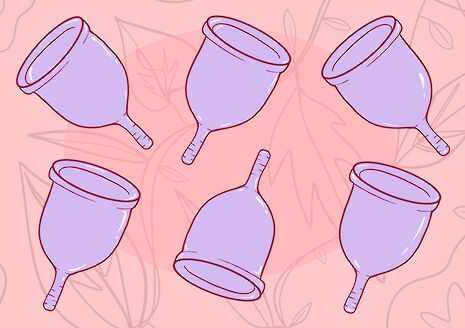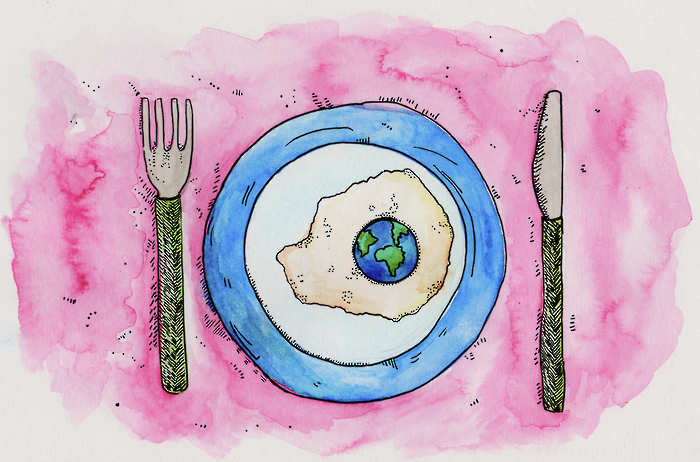Periods and the planet
There are many sustainable alternatives to tampons and pads – so why aren’t we taking them up?

The curse. Code red. Bloody Mary. It’s pretty clear from the language that we use to talk about that time of the month that it isn’t exactly the highlight of a given four-week cycle. But it’s not just our lower abdomens which are calling out for it to stop: with a year’s worth of menstrual products, at average use, generating a carbon footprint of 5.26kg, the impact of our periods isn’t, funnily enough, very well aligned with Mother Nature.
Cotton, used in both sanitary towels and tampons, is an incredibly resource intensive crop, and the plastic packaging of these sanitary products definitely isn’t good news for the planet: one sanitary towel contains the same amount of plastic as a supermarket carrier bag. Moreover, people flushing period products rather than disposing of them in sanitary bins contributes to waste pollution in the ocean.
With the recent rise in awareness of the menstrual cup, it seems that the problem might be fast dissolving. As well as reusable menstrual cups, which are often biodegradable and last for years, options for reduced or zero-waste periods also include renewable disposables (which often use organic cotton, from brands such as Natracare, Ohne, and Freda) as well as washable period pads and panties, which are also better for vaginal health. Companies which make these environmentally-friendly options often have links with period poverty or environmental charities, so your purchase is likely to be multiply ethical. Despite requiring a larger initial investment (menstrual cups, for example, generally cost between £15 and £25), these alternatives do end up working out cheaper in the long-run: people who go reusable will tend to spend far less than the £18,000 which represents the estimated life-time cost of menstruating.
“People who menstruate are already shouldering a burden of discomfort and pain compounded by shame, secrecy, and taboo”
So what’s not to love? Why aren’t the shops running out of menstrual cups and period pants which don’t need to be changed as often as tampons and towels, and have environmental perks to boot? Let’s return to those three euphemisms, which I picked from over 5,000 found in a recent study on slang terms for menstruation in 10 different languages: I think there’s a clue there. I think there’s another clue in that point about women flushing their sanitary waste. Our language, our period practices, our society, is locked into continual attempts to hide the realities of our bodies, to hush up the fact that we’re in a bit of discomfort or quite severe pain, that we’re shedding the lining of an internal organ, that we have done and will continue to do so on a regular basis for most of our adult lives.
Whilst there’s probably more recognition of, and sympathy for, this inevitable aspect of biology than ever before, the fact that these euphemisms are still so readily available, that people are still flushing waste to avoid the embarrassment of it sticking out of the bin, or simply because no one’s ever told them otherwise, are indicators that the taboo around periods is still at large. When the only context in which we talk frankly about menstruation is still often just a single biology lesson or a practical and private parent-child conversation, how are we ever going to be able to substantially relate this apparently personal secret to a global, collective crisis which we should all be working to solve? Until we can have these healthy, open, unashamed, and inclusive conversations about periods, we just won’t be talking about them enough to make the advantages of sustainable options a topic of public interest or discourse.
Our slightly fearful attitude towards and stunted vocabulary of anatomy isn’t helping either. In a society which would usually rather whisper ‘vagina’ Miranda-style, terms like ‘labia’ in the description of how to use a menstrual cup are likely to put off or baffle some of their prospective users. People need to be intimate with their own bodies, in ways which I don’t think we’re really teaching them how to be, in order to feel able to switch to a menstrual cup. They have to be living in an environment where they’re able to boil their menstrual cups on the stove, for example, to sterilise them, an action which family members and housemates who would rather avoid the realities of menstruation are still likely to make uncomfortable. They have to not be paralysed by the fear, on the first few attempts, that they’ll spill, which will only be the case once the shame around natural bleeding – still so potently felt by anyone who’s ever asked their friends to check them as they walk down the school corridor – has dissipated.
People who menstruate are already shouldering a burden of discomfort and pain compounded by shame, secrecy, and taboo. The planet needs our help, but we must be careful not to levy criticism at individuals for the impact of a natural and healthy bodily process when promoting environmental alternatives. Menstrual cups might be a viable solution to tackling worldwide period poverty, but whilst the initial investment is still coupled with the unfamiliar, many are unlikely to feel comfortable making the switch. We should be excited about the unique opportunity we have to contribute to the environmental movement with changes which should be small-scale, and yield other benefits like longer wearability, better vaginal health, and long-term financial savings. But, as it stands, there are still barriers which need to come down so that Aunty Flow isn’t a curse on either Mother Nature or her children.
 Comment / Plastic pubs: the problem with Cambridge alehouses 5 January 2026
Comment / Plastic pubs: the problem with Cambridge alehouses 5 January 2026 News / New movement ‘Cambridge is Chopped’ launched to fight against hate crime7 January 2026
News / New movement ‘Cambridge is Chopped’ launched to fight against hate crime7 January 2026 News / Uni-linked firms rank among Cambridgeshire’s largest7 January 2026
News / Uni-linked firms rank among Cambridgeshire’s largest7 January 2026 News / SU stops offering student discounts8 January 2026
News / SU stops offering student discounts8 January 2026 News / Cambridge businesses concerned infrastructure delays will hurt growth5 January 2026
News / Cambridge businesses concerned infrastructure delays will hurt growth5 January 2026









